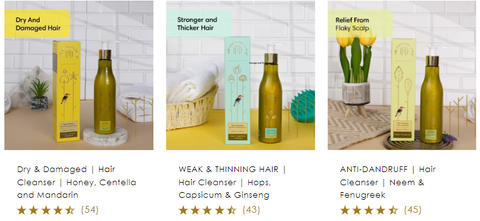Why you should use a hair cleanser
Often overshadowed by its more popular counterpart, shampoo, a hair cleanser offers unique benefits that can transform your hair care routine. Let's look a little deeper into why incorporating a hair cleanser into your regimen can lead to healthier, more vibrant hair.
Understanding Hair Cleansers
Before diving into the benefits, let's clarify what a hair cleanser actually is. Unlike traditional shampoos, which can strip the hair and scalp of natural oils, a hair cleanser is a gentler alternative designed to cleanse without the use of harsh detergents.
Typically formulated with natural ingredients such as botanical extracts and essential oils, hair cleansers effectively remove dirt, oil, and product buildup while maintaining the scalp's natural balance.
Gentle Cleansing for Healthy Scalp
One of the primary reasons to opt for a hair cleanser is its gentle cleansing action, which promotes a healthier scalp environment. Unlike shampoos that contain sulphates and other harsh chemicals, hair cleansers clean the scalp without stripping away its natural oils.
This gentle approach prevents the scalp from becoming dry or irritated, reducing issues like itchiness and flakiness. By maintaining a balanced scalp, hair cleansers create an optimal environment for hair growth, ensuring that your strands are healthy and strong from the root.
Moisture Retention for Hydrated Locks
Another key benefit of using a hair cleanser is its ability to retain moisture in the hair shaft. Traditional shampoos often leave the hair feeling dry and brittle.
In contrast, hair cleansers cleanse the hair while preserving its natural moisture, resulting in softer, more manageable locks. By locking in moisture, hair cleansers help prevent issues like frizz and breakage, leaving your hair looking and feeling healthier with each use.
Nourishment for Improved Hair Texture
Beyond cleansing and moisturising, hair cleansers also provide essential nutrients that improve the overall texture and appearance of your hair. Many hair cleansers are enriched with vitamins, antioxidants, and proteins that nourish the hair follicles, promoting stronger, more resilient strands.
Regular use of a hair cleanser can help revitalise dull, lifeless hair, restoring its natural shine and vitality. Whether your hair is damaged from heat styling or environmental stressors, incorporating a nourishing hair cleanser into your routine can work wonders for its health and appearance.
Versatility for All Hair Types
One of the standout features of hair cleansers is their versatility, making them suitable for all hair types and textures. Whether you have fine, straight hair or thick, curly locks, there's a hair cleanser formulated to meet your specific needs.
Additionally, hair cleansers are free from sulphates, parabens, and other harsh chemicals, making them safe for colour-treated or sensitive scalps. With a wide range of options available, you can easily find a hair cleanser that aligns with your hair goals and preferences.
Environmental Friendliness for Conscious Consumers
In an era where sustainability is a growing concern, many individuals are seeking out eco-friendly alternatives to traditional hair care products.
Hair cleansers offer a greener option, as they are often formulated with natural and biodegradable ingredients that minimise environmental impact. By choosing a hair cleanser that prioritises sustainability, you can feel good about reducing your carbon footprint while still enjoying luxurious hair care benefits.
Whether you're looking to repair damage, enhance texture, or simply maintain your hair's natural beauty, The Earth Collective has a hair cleanser for you. Make the switch to a hair cleanser today and experience the transformative power of gentle cleansing for yourself!





